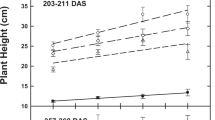Abstract
Knowledge regarding reproductive cycle duration is important in terms of scheduling harvests and estimating coffee cultivars adaptability. Nine Coffea arabica cultivars were evaluated during two successive reproductive cycles. Dates of occurrence of the major blossoms, and the green and ripe fruits, on 64 branches for each cultivar, were registered during each reproductive cycle. These dates were used to calculate the duration of the fruit development (blossom to green) and ripening (green to ripe) phases, the quantities of degree days, precipitation, and solar radiation accumulated throughout each phase, and also degree days, precipitation, and radiation on a daily basis, all of which are novelties in coffee research. The differences between cultivars and reproductive cycles were tested by ANOVA. Cultivars were grouped in clusters according to the above-cited variables. Principally, the daily quantities of degree days and precipitation determined the differences between reproductive cycles and coffee cultivars during development phases. Early and very early cultivars accumulated high numbers of degree days.day−1, in periods of relatively good water availability, with high exposure to solar radiation. Late cultivars accumulated less degree days.day−1 and were exposed to lower amounts of daily solar radiation and longer periods of water scarcity. Regarding the fruit ripening phase, cultivars were principally distinguished by degree days and solar radiation on a daily basis. Two of the coffee cultivars were classified or confirmed as early and very early and another three as late and very late. One cultivar, Siriema, displayed an interesting conjugation of early and intermediate characteristics.




Similar content being viewed by others
Change history
13 June 2019
The article was published with an erroneous rendering of Table 1. The correct rendering of this table is provided below. The original article has been corrected.
References
Aguiar ATDE, Guerreiro-Filho O, Maluf MP, Gallo PB, Fazuoli LC (2004) Caracterização de cultivares de Coffea arabica mediante utilização de descritores mínimos. Bragantia 63:179–192. http://www.scielo.br/pdf/brag/v63n2/21367.pdf. Accessed 15 Oct 2014
Andreazi E, Carducci FC, Sera T, Pereira CTM, Junior VM, Carvalho FG, Shigueoka LH, Santos WGD, Fonseca ICDB, Sera GH (2017) Ciclo precoce de maturação e produtividade em genótipos de café derivados de C1195-5-6-2. Coffee Sci 12:575–582 http://www.coffeescience.ufla.br/index.php/Coffeescience/article/view/1375
Arcila-Pulgarín J, Buhr L, Bleiholder H, Hack H, Meier U, Wicke H (2002) Application of the extended BBCH scale for the description of the growth stages of coffee (Coffea spp.). Annual Applied Biology 141: 19–27. https://onlinelibrary.wiley.com/doi/10.1111/j.1744-7348.2002.tb00191.x. Accessed 13 Nov 2014.
Ayres M (2015) BIOSTAT version:5 http://www.bioestat.software.informer.com
Bardin-Camparotto L, Camargo MBPD, Moraes JFLD (2012) Época provável de maturação para diferentes cultivares de café arábica para o Estado de São Paulo. Ciência Rural 42:549–599 http://www.scielo.br/pdf/cr/v42n4/a9612cr5899.pdf
Camargo AP, Camargo MBP (2001) Definição e esquematização das fases fenológicas do cafeeiro arábica nas condições tropicais do Brasil. Bragantia 60:65–68 http://www.scielo.br/pdf/brag/v60n1/a08v60n1.pdf
Carvalho HDP, Camargo RD, Gomes MWDN, Souza MFD (2014) Classificação do ciclo de desenvolvimento de cultivares de cafeeiro através da soma térmica. Coffee Sci 9:237–244 http://www.coffeescience.ufla.br/index.php/Coffeescience/article/view/623
Felsenstein J (2009) PHYLIP (Phylogeny Inference Package) version 3.695. http://www.evolution.genetics.washington.edu/phylip.html
Fundação Procafé. (n.d.-a) Boletim de Avisos do Sul de Minas. http://www.fundacaoprocafe.com.br/estacao-e-avisos/sul-de-minas/boletim-de-aviso. Accessed monthly from September-2014 to December-2017
Fundação Procafé (n.d.-b). www.fundacaoprocafe.com.br/sites/efault/files/publicacoes/pdf/38 cbpc%20 NovasVariedades Saulo.pdf, accessed in August-4th, 2018)
Gaspari-Pezzopane CD, Bonturi N, Filho OG, Favarin JL, Maluf MP (2012) Gene expression profile during coffee fruit development, identification of candidate markers for phenological stages. Pesq Agrop Brasileira 7:974–982 http://seer.sct.embrapa.br/index.php/pab/article/view/12387
Matiello JB, Santinato R, Almeida SR, Garcia AWR (2016) Variedades de Café. In: Cultura de Café no Brasil: manual de recomendações. Futurama, São Paulo, pp 61–100
Medina-Filho HP, Carvalho A, Medina DM (1977) Germoplasma de Coffea racemosa e seu potencial no melhoramento do caffeiro. Bragantia 36:XLIV–XLVI http://www.scielo.br/pdf/brag/v36n1/41.pdf
Morais H, Caramori PH, Ribeiro AMDA, Gomes JC, Koguishi MS (2006) Microclimatic characterization and productivity of coffee plants grown under shade of pigeon pea in southern Brazil. Pesq Agrop Brasileira 41:763–770 http://seer.sct.embrapa.br/index.php/pab/article/view/7204
Morais H, Caramori PH, Koguishi MS, Ribeiro AMDA (2008) Escala fenológica detalhada da fase reprodutiva de Coffea arabica. Bragantia 67:257–260 http://www.scielo.br/pdf/brag/v67n1/a31v67n1.pdf
Nátrová Z, Nátr L (1991) The utilization of degree days for the characterization of developmental stages of 26 winter wheat cultivars. Biologia Plantarum (Praha) 33:417–429 https://link.springer.com/article/10.1007/BF02897693
Petek MR, Sera T, Fonseca ICDB (2009) Exigências climáticas para o desenvolvimento e maturação dos frutos de cultivares de Coffea arabica. Bragantia 68:169–181 http://www.scielo.br/pdf/brag/v68n1/a18v68n1.pdf
Pezzopane JRM, Júnior MJP, Thomaziello RA, Camargo MBPD (2003) Escala para avaliação de estádios fenologicos do cafeeiro arábica. Bragantia 62:499–505 http://www.scielo.br/pdf/brag/v62n3/v62n3a15.pdf
Pezzopane JRM, Júnior MJP, Camargo MBPD, Fazzuoli LC (2008) Exigência térmica do café arábica cv. Mundo Novo no subperíodo florescimento colheita. Ciência e Agrotecnologia 32:1781–1786 http://www.scielo.br/pdf/cagro/v32n6/v32n6a16.pdf
Pezzopane JRM, Salva TDJG, Lima VBD, Fazuoli LC (2012) Agrometeorological parameters for prediction of the ripening period of Arabica coffee cultivars. Int J Biometeorol 56:843–851 https://link-springer-com.ez298.periodicos.capes.gov.br/article/10.1007/s00484-011-0486-6
Souza CAD, Rocha RB, Alves EA, Espindula MC, Ramalho AR, Teixeira AL, Ferrão MAG (2017) Componentes genéticos do desenvolvimento e do desenvolvimento e maturação de frutos de Coffea canephora Pierre ex A. Froehner Coffee Sci 12:355–364 http://www.Coffeescience.ufla.br/index.php/Coffeescience/article/view/1295
Sureshkumar V, Prakash N, Mohanan K (2010) A study of Coffea racemosa x Coffea canephora var. robusta hybrids in relation to certain critically important characters. Int J Plant Breed Genet 4:30–35 http://docsdrive.com/pdfs/academicjournals/ijpbg/2010/30–35.pdf
Systat Software Inc (2010) Kruskall-Wallis ANOVA on ranks. In: SigmaPlot statistics user’s guide. Systat, San Jose – CA, pp 147–161
Acknowledgments
The authors are thankful to the Embrapa Café Research Program for the financial support (SEG number 02.13.02.017.00.04) and for the fellowships to Juliano de Carli and Isabella Esteves Couto that contributed to collect data. Authors are also grateful to Dr. Heverly Morais and the reviewers, who read the manuscript and encouraged submission.
Author information
Authors and Affiliations
Corresponding author
Ethics declarations
Conflict of interest
The authors declare that they have no conflict of interest.
Additional information
Iran Bueno Ferreira in memoriam
Electronic supplementary material
Supplementary Figure 1
(JPG 195 KB)
Rights and permissions
About this article
Cite this article
da Silva Angelo, P.C., Ferreira, I.B., de Carvalho, C.H.S. et al. Arabica coffee fruits phenology assessed through degree days, precipitation, and solar radiation exposure on a daily basis. Int J Biometeorol 63, 831–843 (2019). https://doi.org/10.1007/s00484-019-01693-2
Received:
Revised:
Accepted:
Published:
Issue Date:
DOI: https://doi.org/10.1007/s00484-019-01693-2




